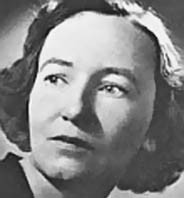
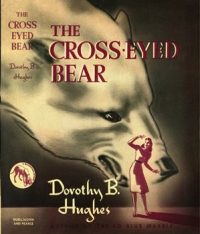
Suspense is compounded of mystery and suspicion and dangerous adventure. In this series are tales calculated to intrigue you, to stir your nerves, to offer you a precarious situation and then withhold the solution… until the last possible moment when we again hope to keep you in…Suspense!
Suspense (1942-1962) aired “The Cross-Eyed Bear” on September 16, 1943 as the 58th of its 945 episodes.
As recounted in the introduction to the more than 50 episodes of Suspense we’ve shared over the past thirteen years, it was such a rich goldmine of superlative stories that when we found this one—a deftly constructed murder-mystery—we couldn’t resist. Suspense was one of the most well produced, written, acted, and critically acclaimed of all radio shows during the Golden Age of Radio, many a film star jumping at the chance to perform in an episode, among them Cary Grant, Orson Welles, Jimmy Stewart, Susan Hayward, Vincent Price, Charles Laughton, Loretta Young, Peter Lorre, and Rita Hayworth. After many another radio show had gasped its last breath during the 1950s, Suspense finally closed shop in September of 1962 whereupon radio historians proclaimed the Golden Age of Radio dead, television having become the medium of choice in America.
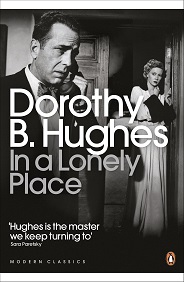 “The Cross-Eyed Bear” first saw print in 1940 and was penned by one of the grand dames of the hardboiled, noir murder mystery, Dorothy B. Hughes (1904-1993, photo top right). Hughes was born and raised in Kansas City, MO and studied journalism at the University of Missouri. She wrote 14 novels from 1940-1952, at which time she concentrated on mystery criticism. Three of her novels were made into feature films, arguably the most recognizable being In a Lonely Place (1947) which was filmed in 1950 and starred Humphrey Bogart and Gloria Grahame. From her wikipedia page: “In 1951 she received an Edgar Award from the Mystery Writers of America in the category of Outstanding Mystery Criticism, and in 1978 she was given the MWA’s Grand Master award.” Hughes noted some of her influences as Eric Ambler, Graham Green, and William Faulkner. None other than noted author Walter Mosley wrote that her fiction “captures an unease under the skin of everyday life in a way that is all her own.”
“The Cross-Eyed Bear” first saw print in 1940 and was penned by one of the grand dames of the hardboiled, noir murder mystery, Dorothy B. Hughes (1904-1993, photo top right). Hughes was born and raised in Kansas City, MO and studied journalism at the University of Missouri. She wrote 14 novels from 1940-1952, at which time she concentrated on mystery criticism. Three of her novels were made into feature films, arguably the most recognizable being In a Lonely Place (1947) which was filmed in 1950 and starred Humphrey Bogart and Gloria Grahame. From her wikipedia page: “In 1951 she received an Edgar Award from the Mystery Writers of America in the category of Outstanding Mystery Criticism, and in 1978 she was given the MWA’s Grand Master award.” Hughes noted some of her influences as Eric Ambler, Graham Green, and William Faulkner. None other than noted author Walter Mosley wrote that her fiction “captures an unease under the skin of everyday life in a way that is all her own.”
“The Cross-Eyed Bear” was the nickname given to a deceased Swedish nickel magnate. He had three sons and hated them all, never allowing them while growing up even to see each other. Before his death he had written a check for three million dollars and tore it into three equal pieces, stating in his will that whichever of the three sons was the last living and had in his possession all three pieces of the check, he could inherit the money, knowing in his heart which of his sons was evil enough to kill his brothers. One of the sons has died and a second lives in Sweden, while the third lives in America and hides his true identity for fear that his remaining brother will have him murdered. The plot thickens when a beautiful young blonde answers an ad in the newspaper for a young woman who likes adventure and is willing to engage in somewhat offbeat work to earn it. I really shouldn’t say more, except that Hughes has woven one of the more sophisticated and satisfying tales of the sort arising from the old chestnut of “conditions to inherit a will” premise, there are several carefully planned plot wrinkles to keep the reader guessing, and it works splendidly. To produce such a worthy half hour drama of this sort from an entire novel is to be commended, and I think you will enjoy giving “The Cross-Eyed Bear” a listen.
Play Time: 29:54
{“The Cross-Eyed Bear” aired on a Thursday evening, which was perfect timing for the neighborhood gang. After school the next day the weekend had begun and the first thing on their minds was a trip to the nearby newsstand to enrich their detective pulp magazine collections, which almost rivaled their science fiction magazine collections. Black Mask (1920-51) was their go-to detective magazine and was considered to be the best detective magazine ever published. It managed 7 issues in 1943 as it was in the midst of switching from a monthly to a bi-monthly schedule. Super-Detective (1940-50) was a revival of sorts of the earlier titled Super-Detective Stories which was launched in 1934 but lasted only 15 issues. It relaunched under its current shorter title after a 5-year hiatus in 1940 and ran successfully for another 65 issues. Upon its relaunch and renumbering it featured a full-length novel with the pulp hero Jim Anthony, a scientist, businessman, and adventurer in every issue. Super-Detective saw 8 issues in 1943, the first 4 being monthly while the final four were bi-monthly. Coincidentally, the Jim Anthony novels were dropped after the issue below, it being the last to include the pulp hero’s adventures. Thrilling Detective (1931-53) was one of the longest running detective pulps, newsstands seeing no fewer than 213 issues during it run. It held to a reliable monthly schedule from 1931 through near the end of 1945, at which time it became a bi-monthly.}
[Left: Black Mask, 9/43 – Center: Super-Detective, 10/43 – Right: Thrilling Detective, 9/43]
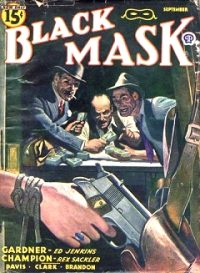
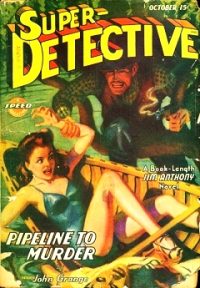
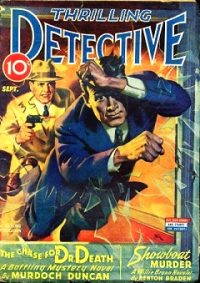
To view the entire list of weekly Old Time Radio episodes at Tangent Online, click here.